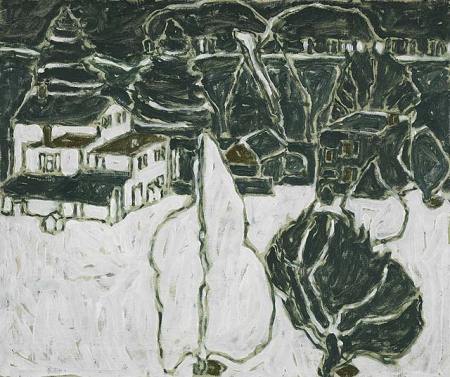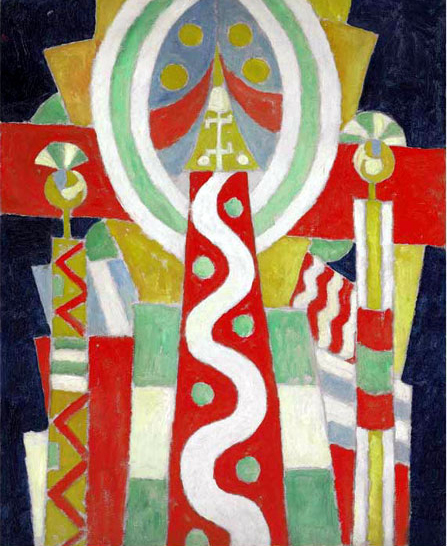 David Milne, Dark Shore Reflected, Bishop’s Pond, 1920
David Milne, Dark Shore Reflected, Bishop’s Pond, 1920
Watercolor on Paper, 38.8 x 55.6 cms
(Private Collection)
Feeling is the power that drives art. There doesn’t seem to be a more understandable word for it, though there are others that give something of the idea: aesthetic emotion, quickening, bringing to life. Or call it love; not love of a man or woman or home or country or any material thing, but love without an object—instransitive love.
—David B. Milne, “Feeling in Painting,” 1948
By LIZ HAGER
© Liz Hager, 2010. All Rights Reserved.
The Titans of 19th and early-20th century landscape art were amply represented in last summer’s meaty exhibition “Expanding Horizons: Painting and Photography of American and Canadian Landscapes 1860-1918” at The Montreal Museum of Fine Arts. The roster of American painters and photographers was an impressive one—Frederick Church, Albert Bierstadt, Thomas Eakins, Marsden Hartley, Georgia O’Keefe, Timothy O’Sullivan, Edward S. Curtis, Carlton Watkins, and Alfred Stieglitz were among the many whose work filled a seemingly endless array of gallery rooms.
For this American visitor, however, the most exciting discoveries in the exhibition were to be found in the ranks of the Canadian artists, a group not as well known below the border. By arranging the exhibition according to six major themes, the curators provided visual evidence of the ways in which Canadian artists were influenced by styles and events in the US over the 60 plus years covered by the exhibition. But this organizing principle also made evident clear points of differentiation and, in doing so, highlighted the essentially Canadian approach to landscape art.
 David Milne, White, the Waterfall (The White Waterfall), 1921
David Milne, White, the Waterfall (The White Waterfall), 1921
Oil on canvas, 45.8 x 56.3 cms
(National Gallery of Canada, Ottawa)
Lacking the notion of Manifest Destiny, Canadian artists were never seduced by epic proportions and panoramic vistas. The talented Group of Seven, working in the first quarter of the 20th century, focused on exploring the unique quality of the Canadian landscape. As a group, their paintings evoke intimate, understated beauty. Additionally, Emily Carr’s soul-full renditions of native peoples and nature were a lovely surprise. American painter Allen Tupper True came to mind as a kindred spirit.
David Milne (1882-1953), however, was far and away the most exhilarating find of that summer day. Present in Milne’s work are the powerful sirens created by Matisse—vibrant line work, sinuous and often voluptuous forms, as well as daring color choices. And yet Milne managed to harness these elements to produce a uniquely expressive statement; his work illuminates the remarkable beauty to be found in the ordinary corners of the natural world.
 David Milne, Black and White Trees and Buildings, 1915/6
David Milne, Black and White Trees and Buildings, 1915/6
Oil on canvas, 51.5 x 61.5 cm
(National Gallery of Canada, Ottawa)
A contemporary of the Group of Seven (although not a member) Milne, was every bit as talented, but never attained commensurate public recognition in his lifetime. By choice, he led an often-solitary and financially-impoverished life. Voluminous letters make clear the extent to which Milne chose artistic expression over financial success, though he worried mightily about providing for his family. As David P. Silcox observes in his David Milne: An Introduction to His Life and Art: for Milne “the making of art meant following a solitary track, not joining art movements or societies, even if it meant living for many years in relative obscurity.”
Milne attended The Art Students’ League in 1904. Although he attempted a career in fine art afterward, earning an income soon necessitated full time work as a commercial illustrator. One of only three Canadians, he exhibited five paintings in the 1913 Armory show. In 1915 he exhibited at the Panama-Pacific International Exposition in San Francisco. These must have been rays of affirmation for the young artist.
David Milne, Side Door, Clarke’s House, c.1923
Oil on canvas, 30.5 x 40.7 cm
(Courtesy McMichael Canadian Art Collection)
Milne’s New York experience was interrupted by World War I. Having joined the Canadian army too late to see action, Milne was sent just after the Armistice to record his impressions of the French and Belgian battlefields for the Canadian War Memorials program. Upon his return to the United States the artist became increasingly more reclusive, relocating from New York to the solitude of the Berkshire and Adirondack Mountains.
Success eluded him over the ensuing decade, however, and in 1928 he moved to a series of locations both outside Toronto and in more remote, rural Ontario. The years of the Great Depression were highly productive ones for Milne. He painted a huge numbers of landscapes, the occasional interior or still life, and, beginning in the late 1930s, an increasing number of fantasy and Biblical scenes. This shift to “spiritual” concerns corresponded with an almost exclusive return to the watercolor medium. For the remainder of his life Milne produced very few oil landscapes.
 David Milne, Painting Place III, 1930
David Milne, Painting Place III, 1930
Oil on canvas, 51.3 x 66.4 cms
(National Gallery of Canada, Ottawa; Vincent Massey Bequest)
In the last years of his life, Milne was diagnosed with cancer. He sketched and painted until the end, when finally a virulent stroke took his life at the end of 1953. He is buried in an unmarked grave in a Toronto cemetery.
Fortunately, since his death, David Milne’s legacy has become better understood. After Milne’s death, art critic Clement Greenberg remarked:
To claim that Milne was arguably Canada’s ‘greatest painter’ is not extravagant. . . I would class him with such as Marin and Hopper in my own country. But he can hold his own anywhere.
(Letter to David Silcox 12/18/1991, from Painting Place: The Life and Work of David B. Milne
)
Milne is remembered as the inventor of the multiple place color drypoint (a process similar to etching that does not require acid bath). The National Gallery of Canada and other institutions have organized retrospectives since his death. The Metropolitan and British museums presented a comprehensive exhibition of Milne’s watercolors in 2005; in fact, in the last decade the British Museum began to acquire a number of Milne works.
This American hopes for more Northern exposure in the years to come.
Wider Connections
David Milne cybergallery at National Gallery of Canada
David P. Silcox—Painting Place: The Life and Work of David B. Milne
Group of Seven repository—McMichael Canadian Art Collection
Katherine Lochnan—David Milne Watercolours
Maureen Mullarkey—“Gilding the Lily” (review of the “Painting Toward Light” Milne exhibition)













